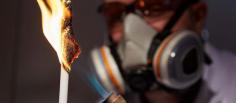In the process, flame testing involves a number of challenges, including how to accurately simulate realistic high-temperature conditions, how to evaluate and interpret test results, and how to regulate and comply.
To address these challenges, flame testing involves many test items and parameters, including ignition time, ignition droplets, burn time and evaluation of product flame retardancy. These test items require high-quality test equipment and tools that are operated and interpreted by knowledgeable and experienced technicians. Through accurate testing and evaluation, manufacturers can ensure the safety and performance of their products in high-temperature environments to meet the needs of their markets and customers.
Challenging the Heat: Flame Testing for Durable and Flame Resistant Fabrics(图1)
However, flame testing is not a simple process; it requires careful planning and execution to ensure the accuracy and validity of the test. Therefore, manufacturers need to ensure that their test equipment and tools can meet the relevant standards and specifications, and that they choose a laboratory or institution that is qualified and experienced to perform and interpret the tests.


